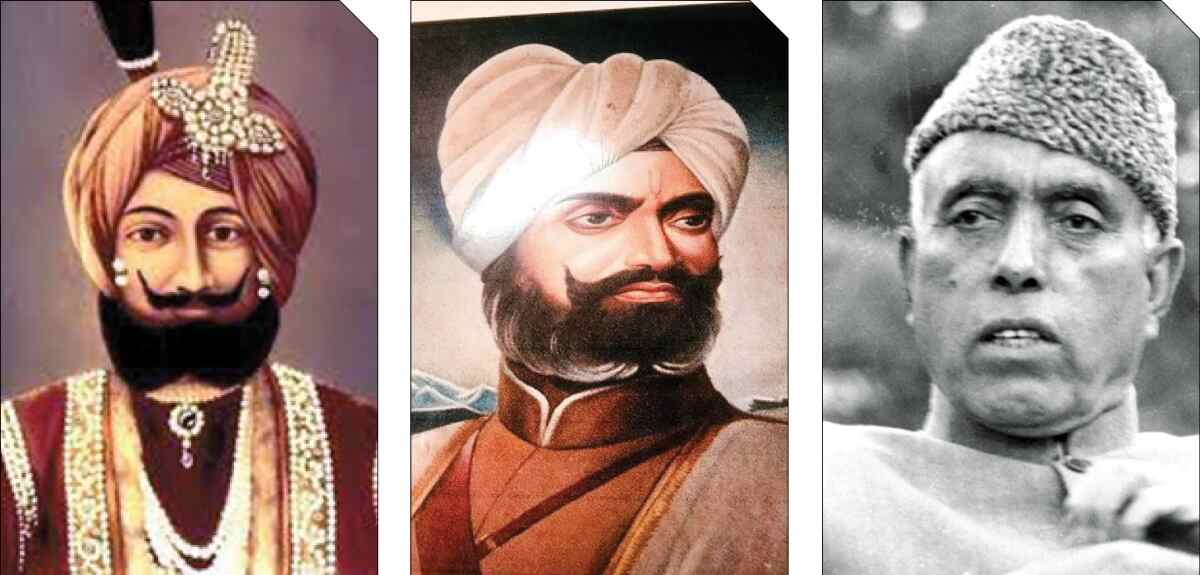Against the 'purchased kingdom'
The legitimacy of the exploitative Dogra dynasty — set up with the ‘purchase’ of the ‘kingdom’— was finally questioned by Sheikh Abdullah who would establish himself in the national political firmament

The origins of the strategically located Riyasat e Jammu wa Kashmir wa Ladakh wa Tibet ha — where Tibet was on the east, the Sinkiang provinces of China to the north-east, Afghanistan on the north-west and the Russian Turkestan just a few miles across — can be traced to 'a sale-deed' signed just after the first Anglo-Sikh war (1845–46) in which the Dogra king Gulab Singh, an erstwhile General and confidante of Maharaja Ranjeet Singh, purchased the 'kingdom' for a sum of 75 lakh Nanakshahi rupees. The British, at that time, had three objectives: to 'weaken the Sikhs' after their defeat at Sobraon, to create a buffer between themselves and Russia on the one hand and China on the other, and to recover the expenditure incurred on the war!
The Dogra's tryst with Kashmir started in 1819 when Ranjeet Singh defeated the Duranni Afghans to lay claim on the state. However, the credit for the territorial expansion of the state into Ladakh in 1834, and Gilgit Baltistan in 1839, must go to Dogra General Zorawar Singh who was then under the Khalsa Raj. Ladakh was an independent state, but culturally a part of His Holiness Dalai Lama's sphere of Tibetan Buddhism. Zorawar Singh later led a successful campaign to Gilgit-Baltistan in 1839/40. The Sikh Dogra control was also established over Yasin, Humza, Darel, Chilas, Chitral and Nagar. Zorawar Singh also led a daring campaign to Tibet in 1841. Even though he was not successful, his gallantry and valour were such that even the Tibetans erected a memorial in honour of their adversary.
Having paid 75 lakh rupees for Kashmir, the Dogra's first objective was to extract this amount from their new subjects. Their approach was not that of a benevolent sovereign – but of a rapacious owner and reinter. Everybody was taxed for everything. This included artisan and craftsmen who led a hand to mouth existence. Their tax dragnet did not spare carpenters, boatmen, butchers, bakers, and prostitutes. A contemporary observer Robert Thorpe, writing in 1860, said "towards the people of Cashmere we have committed a wanton outrage, a gross injustice and an act of tyrannical oppression which violates every human and honourable sentiment..."
With regards to the state appointments, all high offices in the state were filled mostly by Dogra, followed by Punjabis and some Kashmiri Pandits. There were positive externalities as well. Thanks to the spread of compulsory education called 'Zabran', the light of literacy spread to all corners of the state. Among those who attended the compulsory classes was a young boy Abdullah, born eleven days after the death of his father Sheikh Mohammed Ibrahim, in the Soura village on the outskirts of Srinagar. Even though his childhood was mired in poverty, he matriculated and studied at Shri Pratap College Srinagar, Prince of Wales College in Jammu, Islamic College in Lahore and Aligarh Muslim University. It was at AMU that his skills as an organizer and orator first came to the fore. Meanwhile, within the state, resentment against jobs for outsiders was on the rise and, from 1927, the Maharaja was compelled to offer preference to state subjects or Mulkis. To address the grievances and resentment of the Kashmiri Muslims, the Maharaja was compelled to set up an inquiry commission under the chairmanship of Sir BJ Glancy. The committee recommended that Muslims should be given more representation in the services, and that an Assembly should be established in the state. In 1934, Maharaja Hari Singh did establish a Legislative Assembly called the Praja Sabha. However, contrary to the recommendations of the Commission, the elected legislators did not have a majority in the Assembly, the legislative powers were restricted, and the Council of Ministers was appointed by, and responsible to the Maharaja. Rejecting the Assembly, the Sheikh said on January 29, 1934: "the people of this country did not spill blood for such a mock show... what hopes can the people of this country have in this kind of a representative Assembly in which the dead weight of the officials and nominated majority will always be ready to crush the popular voice."
By this time, Sheikh had established himself as an undisputed leader of Kashmir, and the head of the All J&K Muslim Conference. However, it must be placed on record that while he held complete sway over the Kashmiri Muslims, his influence in Jammu, Ladakh and the frontier regions was negligible. Meanwhile, the Congress made overtures to him, and his interactions with Saifuddin Kitchlew, Nehru, Badshah Khan and Mahatma Gandhi convinced him that the J&K Muslim Conference should be made more inclusive and secular. In 1938, Sheikh Abdullah moved a resolution in the working committee of the Muslim Conference that it should change its name from Muslim Conference to J&K National Conference (NC) and open its doors to Hindus and Sikhs. The flag of the party was changed from the 'green with a white crescent' to the 'red with a white plough'. Even though the minority leaders like Budh Singh and Pandit Prem Bazaz joined the NC, it could never really expand its base beyond the Valley. But thanks to the Congress, Sheikh and his party got a national platform. In 1939, Sheikh attended the Tripuri (Jabalpur) session of the Congress, and was also asked to chair a session on the problems faced by people under states (Riyasats). Later, he became the President of All India States Peoples Conference.
Views expressed are personal



